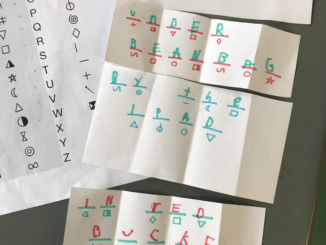This post has an audio and video recorded version for those who prefer to learn by hearing rather than by reading. Scroll to the bottom for the video of me reading it.
On a recent post, I mentioned that I wanted to see if a child could do a particular task—I think it was cutting something out with scissors.
The task was entirely child-led and self-motivated: he is the one who wanted the thing to be cut out with scissors. I was not instructing him to do it.
Despite being very motivated for it to be done, I suspected that if he could, he would simply hand it to me and ask me to cut it out for him. I also suspected that he was very capable of cutting it out himself. I also knew for a fact that cutting was something that, to him, for some reason, feels very worrying. He is very afraid of failing at cutting something out neatly.
I wanted to see if he could do it. I want his skills (and confidence) to improve, and we were in the perfect situation for it: extremely low-stakes, we could just get a new piece of paper if this one went badly, he was motivated for it to happen, etc.
So, I did something that I do with some frequency in both OT and in parenting when I want to see if my kids will try something. I “made myself busy”.
At work, I usually grab the nearest craft supplies and start just “making something”. Never once have I had a kid call me on it, like, “wait, why do you need to paint that right this second?” even though an adult would probably question that. The kids are familiar with their own impulse to paint a random thing if there’s paint out and available, so they just go with it. 🙂
At home, I’m more likely to do some small nearby cleaning task. (For example, sweep up an area of the kitchen floor, or wipe off a counter, or whatever.)
I do this when I know a child well enough to have a reasonable estimate of their skills, and when there is a task that has come up in play that I suspect they could do independently. I always choose tasks to “busy myself” that could be quickly dropped if they became distressed or genuinely needed my help. (There’s fewer of these at work, since obviously at work my literal job is to be there for the child right then. But for example, at home, I wouldn’t start cooking something because that takes too much genuine attention, involves heat, etc.)
This happens in work constantly with fine motor tasks, like drawing, writing, cutting with scissors, etc. It also happens surprisingly often with kids wanting to move the gym elements around, for example, pull a mat or a tunnel around in the gym so they can crawl through it elsewhere. If I look busy, they’ll do all that pulling, pushing, motor planning, strengthening work by themselves. If I go do it for them they’ll sometimes fully let go of the thing and just expect me to move it while they direct.
There are degrees of participation I’ll do…
- I’ll try to be totally busy and uninvolved (to let them do all the strengthening work). If neither of us say anything at all, great! That means they were soooo focused on their task that it didn’t even occur to them to ask me to do it for them, which is fabulous and means whatever they were doing was REALLY meaningful to them.
- If they start to do the task and realize it’s hard, they might yell for me to come join them. Then I’ll say something like “Sure thing! In just a second! You can go ahead and get started if you want and I’ll be right there.” I always make sure that I lead with a “yes” or some variant of it. “Yes! I will, give me two seconds.” “Absolutely! Oh, cool, you’re taking that over there? Let me put this down and I’ll come help you.”
- I then adjust how fast I actually get over to them based on a zillion different factors…how much do they already trust me? How close to the line between “enjoyable challenge” and “frustrating, distressing obstacle” are they currently? How is their frustration tolerance? How much are they standing over there staring at me versus tackling the task themselves? Will the task take 2 seconds once they start it or will it take 5 minutes?
- If it gets to the point where I should actually go help, I’ll go help but begin with as minimal help as possible. This might look like standing there doing my best “slightly clueless adult” impression while I have them explain to me what it is they want, because they’ll often start doing it themselves as they explain…and then they might realize they can do it… etc.
- If I begin helping in earnest, I do my best to involve them as a co-partner in doing the thing. For example, if it’s cutting with scissors, I might offer, “What if I held the paper still?” or “what if I trace it and then you cut it?” If it’s moving a large heavy mat, I might simply hold it slack enough in my hand that I know they’re at least holding some or most of the weight of it.
There are always a few times when I might actually just do a task for a child.
- They might be extremely new to me and my room and not have a trust-based rapport yet.
- They might be extremely tentative to offering up their own ideas, or used to having their ideas shot down; then if they’re willing to say “I want to make a thing…could you please cut it out?” I will absolutely do it for them. (I’m valuing them offering the idea more than them cutting with scissors for 10 seconds.)
- They might be new to self-advocacy, and asking for help is an improvement on just screaming in frustration! Or screaming in frustration is an improvement on throwing objects in frustration! And I absolutely want to work with them on their emerging self-advocacy skills.
- They might have already worked on 50 things today (maybe with me, maybe not with me) and this is just one…too…many and I respect that.
- They might not be regulated enough for a nudge in a strengthening direction, and we’re only working on getting regulated right then.
The list could go on and on. This is absolutely not something that I can make a handy flowchart out of and you just do it exactly how I do it…it’s the kind of thing that takes emotion and thinking and empathy and being present with the child, and trial and error sometimes, and doing the best you can, and knowing you can fall back on your relationship together.



